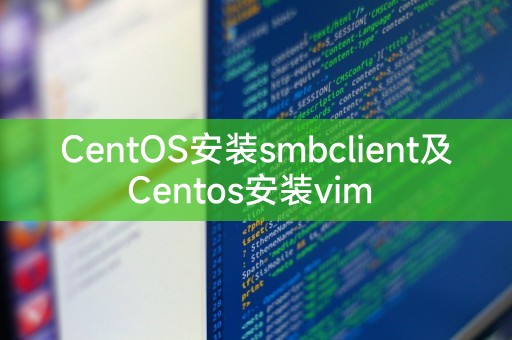
php editor Youzi will introduce to you how to install smbclient on CentOS and install vim on CentOS. smbclient is a tool for communicating with Samba servers, which allows us to access and share file and printer resources on a Windows network on a Linux system. Vim is a powerful text editor that supports multiple programming languages and has rich editing functions and plug-in extensions. In this article, we will introduce you in detail the steps and precautions for installing smbclient and vim on CentOS systems to help you better use and manage your system.

1. Open a terminal and log in as root user.
2. Run the following command to update the system package list:
```
yum update
3. Run the following command to install smbclient:
yum install smbclient
4. You will be prompted to confirm the installation, press the y key and press Enter to continue the installation.
5. After the installation is complete, you can verify whether smbclient was successfully installed by running the following command:
smbclient --version
You should be able to see the version information of smbclient .
3. Run the following command to install vim:
yum install vim
5. After the installation is complete, you can verify whether vim was successfully installed by running the following command:
vim --version
You should be able to see the version information of vim.
Once smbclient is successfully installed, you can use it to communicate with SMB/CIFS servers. Here are some commonly used smbclient command examples:
1. Connect to the SMB shared directory:
smbclient //server/share -U username
Replace "server" with the actual server name, "share" with the name of the shared directory, and "username" with your username.
2. List the files and folders in the shared directory:
ls
3. Download the file to the local computer:
get filename
Replace "filename" with the name of the file you want to download.
4. Upload files to the shared directory:
put filename
Replace "filename" with the name of the file to be uploaded.
For more information about smbclient commands and usage, please refer to the official documentation of smbclient.
vim is a powerful text editor that can meet various text editing needs. The following are some commonly used vim command examples:
1. Open a file:
vim filename
Replace "filename" with the name of the file you want to open.
2. Insert text:
Press the i key to enter insert mode, and then start entering text.
3. Save the file:
Press the Esc key to exit insert mode, then enter the following command to save and exit:
:wq
4. Exit Do not save:
Press the Esc key, and then enter the following command to exit without saving:
:q!
For more commands and usage of vim, please refer to vim's Official documentation.
In Linux systems, there is a very useful command called "grep". The grep command is used to search for a specified pattern in a file and print out the matching lines. It can help you quickly find and filter file, you can use the following command to search for files containing specific keywords:
grep "keyword" filename
Replace "keyword" with the keyword you want to search for, "filename "Replace " with the file name to search for.
Hope this little knowledge is helpful to you!
The above is the detailed content of Install smbclient on CentOS and install vim on CentOS. For more information, please follow other related articles on the PHP Chinese website!




